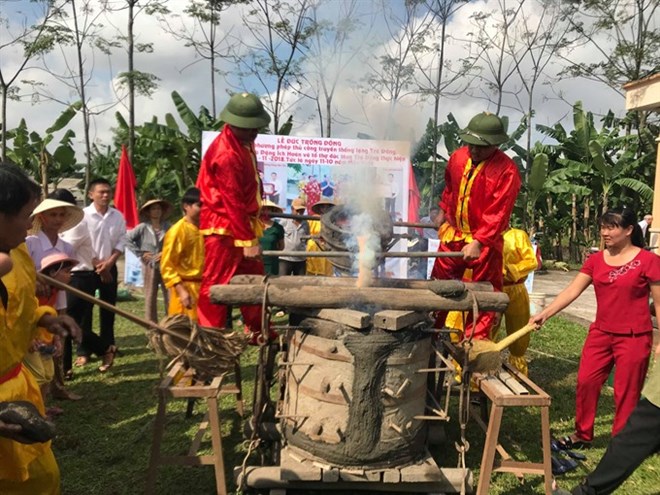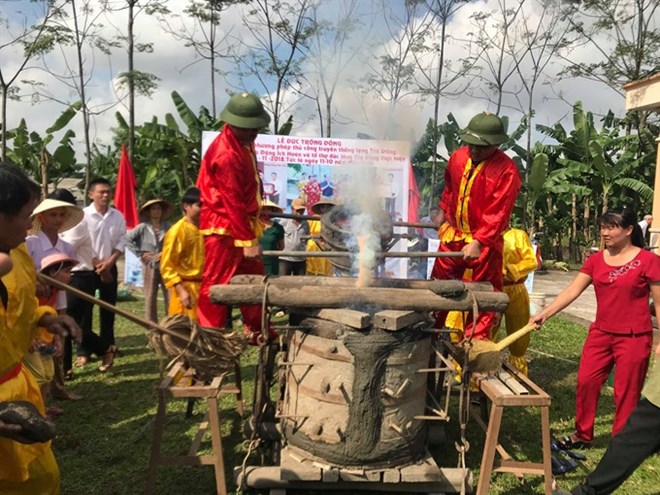
Bronze casting in Che Dong village in the central province of Thanh Hoa has officially received a certification recognising it as a National Intangible Cultural Heritage, making it the seventh local heritage to receive the title in the country.
Artisans from various workshops in Che Dong Village show off their bronze casting skills.(Photo: VNA).
The traditional handicraft and trade of Che Dong village have
existed for thousands of years and have been preserved and promoted to this day.
The trade comprises a sophisticated technical process
involving many stages, each of which uses different techniques like moulding,
mixing the compound, heating and casting.
Experience is often passed down through families and kept
secret from other villages. This is why Che Dong village is the only place in
Thanh Hoa province that has preserved the art.
All the bronze items they make are meticulously crafted by
hand.
Local artisans create items of worship, jars and particularly
drums. They created the biggest bronze drum in Vietnam at 1.21m high in 2007,
and then the biggest bronze drum in the world which weighs around eight tonnes
and is two metres high in 2013.
The artisans in Che Dong village also cast 100 bronze drums
as a tribute to celebrate the 1,000th anniversary of Hanoi in 2010.
Thanks to these outstanding achievements, the Ministry of
Culture, Sports and Tourism issued the decision to bestow the title on
September 4.
Addressing a ceremony held on Saturday to mark the
recognition, vice chairman of the Thanh Hoa provincial People’s Committee Pham
Dang Quyen affirmed that the recognition brought both honour and pride to the
villagers and people of Thanh Hoa.
"In the short term, local administrators need to focus on
creating favourable conditions for the workshops, artisans and villagers to
preserve and promote the invaluable heritage of their ancestors.
"Besides re-planning the village, more incentives should be
issued to encourage workshops and artisans to train and pass the trade down to
younger generations. The bronze workshops also need to support each other to
produce and promote bronze casting to make it become a major trademark in both
domestic and international markets,” Quyen added.
Also at the ceremony, artisans showed off their skills to
attendees.
According to the Thieu Trung communal People’s Commune, 132
households in the commune were maintaining the traditional trade, but only 15
households at a professional level, concentrated mainly in Che Dong village.
Source: VNA
With an increasingly vibrant and widespread emulation movement aimed at building cultured residential areas and cultured families, Yen Thuy District has been making steady progress toward improving both the material and spiritual well-being of its people, while fostering a civilized, prosperous, beautiful, and progressive community.
Once lacking recreational spaces and community facilities, Residential Group 2 in Quynh Lam Ward (Hoa Binh City) has recently received attention for the construction of a new, spacious, and fully equipped cultural house. The project followed the model of state support combined with public contributions in both labor and funding.
The "All people unite to build cultural life" movement, which has been effectively integrated with Kim Boi district’s socio-economic development goals, is fostering a lively spirit of emulation across local residential areas, hamlets, villages, public agencies, and enterprises. In addition, through the initiative, traditional cultural values are being preserved and promoted, while community solidarity and mutual support in poverty reduction and economic development are being strengthened.
A working delegation of the Hoa Binh provincial People’s Committee led by its Permanent Vice Chairman Nguyen Van Toan on June 11 inspected the progress of a project to build the Mo Muong Cultural Heritage Conservation Space linked to tourism services in Hop Phong commune, Cao Phong district.
Born and growing in the heroic land of Muong Dong, Dinh Thi Kieu Dung, a resident in Bo town of Kim Boi district, in her childhood was nurtured by the sweet lullabies of her grandmother and mother. These melodies deeply imprinted on her soul, becoming an inseparable part of her love for her ethnic group's culture. For over 20 years, this love for her hometown has driven Dung to research, collect, and pass down the cultural values of the Muong people to future generations.
In the final days of May, the Ethnic Art Troupe of Hoa Binh Province organized performances to serve the people in remote, mountainous, and particularly disadvantaged areas within the province. These were not just ordinary artistic shows, but they were the meaningful journeys aimed at spreading cultural values, enhancing the spiritual life of the people and contributing to the preservation of ethnic minority cultural identities.



